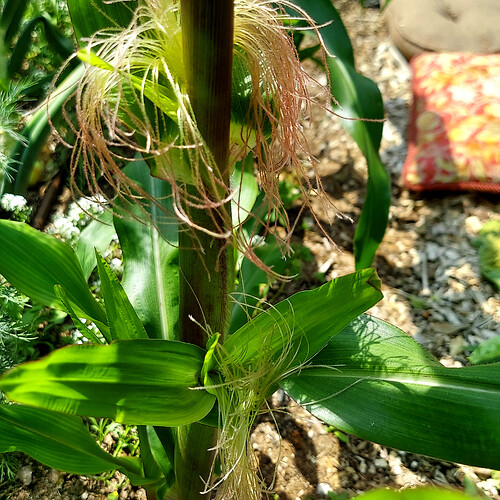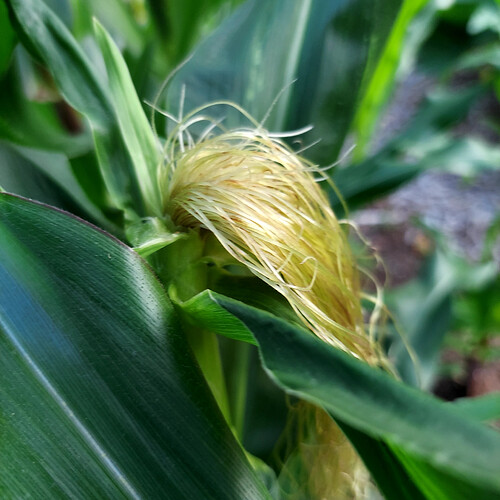It’s really putting on some size now, some of the tassels are very dark colored. Still doing great with no ferts/water.
Just noticed silks this morning, I’m starting to think maybe it got stressed by the early cool temperatures, we’ve had an unusually cool spring here. Probably going to hand pollinate these just to be safe.
These are lovely and looking great! Do you have any with good aerial roots?
Just a couple with what is typically called brace roots or feeder roots around here. This is the only pic I have.
This is probably the most interesting plant for me. Possibly 4 ears forming and a second tassel head all from one 5 ft tall plant. Most of the other stalks are 6ft or higher now.
I was hoping some might have more than brace roots. Thanks for looking!
That plant is going crazy! Wow!
That plant looks very much like it has a bit of primitive teosinte in its ancestry. If so, it might be a bit indeterminate, continuing to set new ears and tassels for a long period compared to most corn. If those tillers fall over, they might root down to the ground with the top part curving back up to tassel and silk some more.
Teosinte is a really interesting plant.
Oh wow, that would be cool as hell.
It is cool as hell. I haven’t had a plant with that much apparent influence of teosinte for several years as I opted to back cross it to modern corn too many times, speeding up the process of getting ears with larger kernels but at the same time losing much of that wild and crazy tillering and continuous flowering. It is still in my corn’s ancestry but rarely presents like that anymore.
What would be really cool, I think, would be to leave it in that state and let it find its own way to making larger ears and kernels. Say for example a person had fifty F1 teosinte plants, (1/2 teosinte, 1/2 modern), maybe cross one more time to end up with 1/4 teosinte but then leave it alone and from then on just select for bigger kernels and ears. Better yet leave it 1/2 and 1/2, although selection would take longer. I’m talking years, maybe lots of them, but it might end up with landrace of usual qualities and adaptability.
I’m finding several plants now with extreme tillering. I believe some of the corn is ready and will check tomorrow morning. The 2 rows that were planted 7 days after the first two have now caught up with the others. Even some of the corn that have set multiple cobs are still making new tassels and silks. Overall it looks like great production. I’ll get all of the numbers post harvest. Really excited to see what they look like. Hopefully I had good pollination.
Looks like some teosinte genetics are strong in this mix. Really looking forward to seeing what the cobs are like coming out of this, especially on that heavy tillering plant.
This is weird. This was from a tiller, is this something that I should also save seed from, or are these typically thrown away?
I think it might not make much difference to keep these seeds if the plant they come from has all normal cobs on the other tillers. You can also make selections in the next generation or so if you see this happening in the future and do not want it. If you don’t want these seeds in particular, consider sharing them in our upcoming seed catalog. It will be interesting to see what comes out of them in the future.
Since this plant seems to be highly influenced by teosinte genetics, it might take some generations for you to get something you want out of it. Crossing it with non-tillering plants with single or double cobs will help it become more like the cobs we’re used to on corn. Some people are working with smaller cob sizes and have interest in the teosinte morphology for other reasons.
If the teosinte characteristics are something you’re interested in working with, you might enjoy this blogpost.
I’m completely open to whatever happens. I just wasn’t sure if these would even be viable. I’m just not familiar with this kind of thing in corn. It looks like a cob of little eyeballs, pretty cool in my opinion, especially for something like Halloween decorations.
As long as the teosinte stays strong in your mix those weird things will show up. Tassels forming kernels, ears with tassels, tillers all over the place. That’s about the point where I started detasseling the strongly teosinte plants and pollinating with more traditional looking corn.
It’s also the point where, if you had the time, it might be really fun to just leave it alone and select for more normal and larger ears without diluting further diluting the teosinte.
I will likely cross mine with Silver Queen and probably some of the high beta-carotene varieties. A landrace Silver Queen would be a big seller in my area. I pulled back some husk yesterday and the two I looked at actually looked normal, yellowish white kernals neat and straight. They look to be around a week or so from ripeness.
I am posting more on my GTS Seed grow post but just to drop a germination note here.
I planted GTS Sweet Corn Mix 2023 5 days ago.
It was the hottest day of the year so far yesterday so on day 4 I did not go outside in the garden. Heat + High Humidity combined to create a high feels like.
Day 5 I saw that the high winds and rain from the storms that bubbled up and blew over had collapsed the wood chips back down into the rows I scratched out. In the heat I wasn’t going outside to clear them so now the corn will face pill bug pressure from emergence.
What did I see today, day 5.
Corn emerging with various amounts of pill bug pressure. Let’s see how they go, will they continue to push on through or succumb to the hungry land crustaceans?
These look great. I often have initial damage on germinating corn but find it they grow out of it.
I hope you keep getting rain to offset the heat.

















